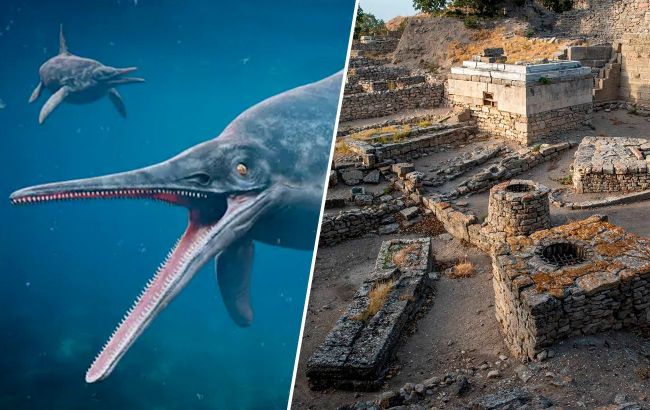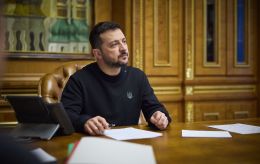Famous discoveries made by amateurs
 Discoveries made by non-professionals (collage: RBC-Ukraine)
Discoveries made by non-professionals (collage: RBC-Ukraine)
In the world of science, there is a belief that discoveries and breakthroughs are made by professionals. However, the reality is even more amazing: behind these unique moments are ordinary people whose passion and curiosity have led to discoveries that have changed our perception.
RBC-Ukraine has gathered information about well-known discoveries and findings made by amateurs without even realizing it.
Sources used in preparing the material include: ZDNet, Oxford Royale, Elsevier SciTech Connect.
Troy discovered by an accountant and broker
Johann Heinrich Schliemann was born into a poor family and spent his childhood with various relatives, working various jobs. Determined to change his life, Schliemann enthusiastically embarked on self-education, mastering English, Dutch, French, and Spanish, after which he secured a position as an accountant in an Amsterdam trading firm.
By the age of 36, he had risen from an office clerk to a stockbroker, amassing a fortune in the process. His wealth was the result of successful participation in the Crimean War of 1854, during which he dominated the market for saltpeter, sulfur, and lead, profiting from the arms trade.
However, material success held little interest for Schliemann. Since childhood, he has been fascinated by the works of Homer and ancient Greek civilization. He independently learned ancient Greek. Almost his entire life, Schliemann dedicated to the search for the cities mentioned in the Iliad and the Odyssey.
From 1868, he actively traveled through Greece and Turkey, funding his own archaeological excavations. In 1870, he began excavations in Hissarlik, Turkey, and by 1873, he had discovered nine buried cities, including the famous Troy.

Remains of the ancient city of Troy (Photo: Wikipedia)
Viruses-Bacteriophages discovered by winemaker and sanitary worker
Félix d'Hérelle, born in Canada, always dreamed of adventures from his childhood. His family, which had emigrated to Canada, returned to Paris after his father's death. There, Félix completed high school, acquiring his only formal education in his life.
When he turned 24, d'Hérelle returned to Canada. Without professional skills, he suddenly developed an interest in microbiology, set up his own laboratory, and began conducting research out of sheer curiosity.
For a while, he also worked as a sanitary worker on a geological expedition in Labrador, although he had no formal medical education. However, such temporary jobs did not provide sufficient income to support his family.
Faced with the question of where to get money, d'Hérelle attempted to start a business with his brother by investing in a chocolate factory, but it soon went bankrupt, leaving the unsuccessful businessmen on the verge of bankruptcy.
Then, with the help of his late father's friend, d'Hérelle obtained a grant from the Canadian government to study the fermentation and distillation of maple syrup into schnapps - and suddenly his experiments were successful.
Later, he moved with his family to Guatemala and obtained a position as a bacteriologist at the capital hospital - again without formal education. Félix treated people for malaria and tropical fever while concurrently inventing a process for making whiskey from bananas.
Under Félix's command in Mexico, a distillery was built that turned the desert plant into alcohol.
Soon, d'Hérelle returned with his wife and daughters to Paris. The First World War had just begun, and Félix started producing medicines for the needs of the army. It was during this time that the self-taught microbiologist made a discovery that made him famous. He found that there are viruses that kill bacteria, and he called them bacteriophages.
D'Hérelle's bacteriophages caused a sensation because at that time antibiotics did not yet exist. Félix successfully treated dysentery, cholera, and even plague with viruses. For his research, he traveled to India, China, and Egypt. In 1928, he gained recognition and became a professor at Yale University in New Haven.
Later, bacteriophages were temporarily forgotten, as it was not easy to find the right virus for treating a specific disease. It was simpler and cheaper to use the newly discovered antibiotic, penicillin.
But in our days, Félix d'Hérelle's discovery has been remembered again because the number of antibiotic-resistant strains is increasing, and humanity needs new ways to combat them.

Félix d'Hérelle (Photo: Canadian Medical Hall of Fame)
Planet Uranus was discovered by a violinist
Frederick William Herschel, born in Hanover in 1738, arrived in England at the age of 19. His musical education was acquired through playing the violin and oboe. Later, he became a prominent composer, and his main profession was conducting the Bath orchestra in Britain.
Simultaneously with his musical career, Herschel, together with his sister Caroline Frederick, studied mathematics, optics, and astronomy deeply for the sake of personal interest. Later, another brother, Alexander, who worked as a mechanic, joined these pursuits.
Engaging in astronomical observations regularly with Caroline Frederick, they discovered two satellites of Saturn - Mimas and Enceladus, identified seasonal changes in the caps on Mars, and compiled a catalog of 2,500 nebulae.
Herschel revealed the existence of binary stars, first estimated the size and shape of our Galaxy. But perhaps his most famous discovery was the giant planet Uranus.
Initially, Herschel mistook Uranus for a comet, but then realized that it was a fully-fledged planet and, moreover, quite large. He was awarded the highest honors in the English scientific community for this discovery.
He became the court astronomer of King George III, moved with his family to a prestigious area near Windsor Palace, and received a generous salary.
Ironically, Herschel never came up with a name for Uranus. For a long time, this object was called the Herschelian Planet or the Planet George in honor of the king, under whose patronage Frederick worked as an astronomer.
The name for this giant was later given by the astronomer Johann Bode, deciding that if all celestial bodies are named after deities from ancient mythology, Herschel and George in the heavens seem superfluous.

William Herschel (photo: Wikipedia)
Plesiosaurs and Ichthyosaurs were discovered by a housewife
On August 19, 1800, when Mary Anning was just 15 months old, her father's neighbor, Elizabeth Haskings, along with two of her friends, set out for a horse show, taking the little girl with them. The women and the child took shelter under a large elm tree. Suddenly, a thunderstorm broke out, lightning struck the tree, and all three women perished. Mary, however, survived.
In the following years, Mary Anning's exceptional intelligence was often attributed to this incident.
Mary's father was a carpenter, but out of curiosity, he collected various fossils, including prehistoric ammonite shells, vertebrates' skeletons, and more. After his death, the family sold most of the collection to improve their financial situation. However, Mary inherited her father's interest in antiquity.
She had no formal education but possessed reading and writing skills. At the age of twelve, she discovered and described an Ichthyosaur skeleton. Later in life, she became the first person worldwide to find almost complete skeletons of Plesiosaurs and the first Pterosaur remains outside of Germany.
Mary was also the first to suggest that coprolites, often found in the habitats of ancient creatures, were fossilized feces. Previously, British gentlemen scientists incorrectly believed them to be undigested food fragments trapped in the stomachs of prehistoric animals.
Today, Mary Anning is rightfully considered one of the first paleontologists. In the 19th century, when gender equality was not a prominent issue, she did not receive recognition during her lifetime. Her discoveries, which she shared with the Geological Society of London, were often credited to her male colleagues.

Mary Anning (photo: National Geographic)
The onset of global warming was proven by a steam engineer
Guy Stewart Callendar, born in 1898, was the son of a professor specializing in thermodynamics. Following in his father's footsteps, Guy studied the properties of steam at high temperatures and pressures. Eventually, he became an engineer involved in designing steam turbines, achieving significant success in this field.
However, in history, he left his mark not as a technician but as an amateur climatologist who first predicted the onset of global warming. After completing his main work, Callendar delved into researching the Earth's climate history, relying on the work of prominent 19th-century meteorologists.
He collected temperature data from around the world and compared them with archival records. As a result, Callendar correctly linked the greenhouse effect in the planet's atmosphere to the increase in carbon dioxide concentration. Modern research confirms the remarkable accuracy of his calculations, especially considering that he performed them without the use of computers, which were not yet invented.
Without formal education, Guy Stewart Callendar published over 35 significant scientific papers on global warming, infrared radiation from the planet, and anthropogenic carbon dioxide from 1938 to 1964.
His works, initially met with skepticism by the scientific community, later convinced most meteorologists of the need to study CO₂ concentration in the atmosphere. And now, the impact of carbon dioxide on the climate is referred to as the Callendar Effect.
Perhaps if Callendar had not delved into the numbers after his work, we might still not be considering a transition to renewable energy sources and would be wondering why the Earth's polar ice caps are melting.
By the way, Callendar believed that global warming would ultimately be beneficial for humanity, as it would improve conditions for agriculture and postpone the onset of the next Ice Age.

Guy Stewart Callendar (photo: Semantic Scholar)
An ancient rock calendar deciphered by a furniture restorer
Have you ever wondered why ancient people depicted deer, mammoths, and other animals on cave walls? For a long time, scientists believed it was a primitive form of art created simply due to a lack of other activities. However, British furniture restorer Bennett Bacon offered a different explanation for cave paintings.
He began to look for repeated patterns and regularities in rock paintings and found them. Bennett compared dots and marks on the drawings with the lunar calendar and discovered that they were related to the reproductive cycles of the ancient animals depicted by people.
Sharing his observations with scientists from Durham University, Bennett surprised them. They double-checked the data and wondered how they could have missed what an ordinary person noticed. In any case, Bennett's conclusions were published in the Cambridge Archaeological Journal.
Now, thanks to the furniture restorer, we know that cave paintings are not just art but rather utilitarian notes for hunters.

Bennett Bacon carves a wooden dragon (photo: The Art Workers' Guild)
And we also have a feature on the top 10 inventions of 2023 according to TIME magazine.

